Download this report as a 94-page PDF - USGS
Download this report as a 94-page PDF - USGS
Download this report as a 94-page PDF - USGS
You also want an ePaper? Increase the reach of your titles
YUMPU automatically turns print PDFs into web optimized ePapers that Google loves.
Table 4.6. Number of observations by breeding behavior for birds, Fort Bowie NHS, 2003 and 2004. Breeding behaviors<br />
follow standards set by NAOAC (1990).<br />
Nest Adults carrying Other<br />
Feeding<br />
recently Recently<br />
With With Nesting Distraction fledged fledged<br />
Common name Building eggs young Occupied Food material displays young young Totals<br />
Gambel’s quail 1 1<br />
Cooper’s hawk 2 2<br />
white-winged dove 1 4 5<br />
mourning dove 14 14<br />
black-chinned hummingbird 1 1<br />
broad-tailed hummingbird 1 3 2 6<br />
ladder-backed woodpecker 1 1<br />
Say’s phoebe 2 1 3<br />
brown-crested flycatcher 1 1<br />
C<strong>as</strong>sin’s kingbird 1 2 1 4<br />
western kingbird 1 1<br />
Bell’s vireo 1 1 2<br />
western scrub-jay 1 1<br />
barn swallow 1 1<br />
verdin 1 1<br />
cactus wren 1 1 2 4<br />
rock wren 1 1<br />
canyon wren 1 1 2<br />
Bewick’s wren 1 1 2<br />
black-tailed gnatcatcher 1 1<br />
northern mockingbird 1 2 3<br />
curve-billed thr<strong>as</strong>her 1 1<br />
crissal thr<strong>as</strong>her 1 1<br />
phainopepla 1 1<br />
summer tanager 2 2<br />
canyon towhee 1 2 2 1 1 7<br />
black-throated sparrow 1 1 1 4<br />
northern cardinal 1 1 1 3<br />
brown-headed cowbird 1 1<br />
hooded oriole 1 1 1 3<br />
Bullock’s oriole 1 1 1 3<br />
house finch 1 1<br />
Totals 5 1 2 35 10 3 2 16 9 84<br />
Discussion<br />
B<strong>as</strong>ed on our research and that by others, Fort<br />
Bowie NHS h<strong>as</strong> a diverse bird community (n = 189<br />
species) for a small area (405 ha) with little<br />
topographic relief. Although the pattern of<br />
extraordinary species richness that we observed in<br />
plants (Chapter 3) w<strong>as</strong> not mirrored in the bird<br />
community, the diversity of vegetation<br />
communities at the sites clearly plays a role in<br />
24<br />
determining the bird community. For example,<br />
there were notable differences in the bird<br />
communities along the two repeat-visit VCP<br />
transects where the Siphon Canyon transect had<br />
almost twice <strong>as</strong> many species <strong>as</strong> the Butterfield<br />
transect (Tables 4.3, 4.4).<br />
Many of the species that we found in the<br />
Siphon Canyon transect are known to occur<br />
primarily in riparian are<strong>as</strong> or are<strong>as</strong> of dense<br />
vegetation: Bell’s vireo, summer tanager, hooded

















